A Methodology to Investigate the Deviations between Simple and Detailed Dynamic Methods for the Building Energy Performance Assessment
Abstract
1. Introduction
2. Materials and Methods
2.1. Calculation Methods
2.1.1. Detailed Dynamic Simulation Method—EnergyPlus
2.1.2. Hourly Method—EN ISO 52016-1
2.2. Workflow
- ambient temperature since it causes the heat transfer by thermal transmission, T-tr,
- ambient temperature since it causes the heat transfer by ventilation, T-ve,
- internal heat sources, Int,
- solar radiation, Sol.
- A first simulation is run using a dead band thermostat with the lower limit equal to the heating set-point temperature, the upper limit equal to the cooling set-point temperature, and considering all the driving forces. The hourly values of the indoor temperature obtained as outputs are used as a fixed set-point temperature schedule in the subsequent simulations.
- A second simulation is performed removing the solar radiation and the internal heat sources, so that the only considered driving force is the ambient temperature. In this way, it is possible to identify the only effect of the outdoor temperature (T-tr), which determines thermal transmission through the envelope components, on the AHB terms. The AHB terms are the convective heat flows that are exchanged between the internal air and the surfaces of the building components. The heating/cooling loads can be determined as well. The effect of ventilation due to the outdoor air temperature (T-ve), as a purely convective thermal load, can be obtained directly.
- A third simulation includes the internal heat sources (Int). It is possible to identify the convective part of the internal heat gains, which is a direct load on the node air, and the convective heat flows exchanged between the internal air and the surfaces due to the radiative part of the internal heat gains, by difference from the second simulation.
- Finally, the comparison between the third and the first simulation allows to identify the contribution of the solar radiation (Sol), in terms of the convective heat flows exchanged between the internal air and the surfaces, due to the solar radiation entering into the room through the envelope components.
3. Application
3.1. Case Study Description
3.2. Boundary Conditions and Simplifying Assumptions
- building envelope without thermal bridges,
- neither ground nor unconditioned rooms as boundary spaces,
- absence of external obstructions (no solar shading).
3.3. Consistency Options of Input Data
- Heating and cooling set-point temperatures. For both models, heating and cooling set-points are referred to the operative temperature.
- Sky temperature. The extra thermal radiation to the sky was modeled fixing an 11 K difference between the air temperature and the apparent sky temperature, as specified in EN ISO 52016-1.
- Convective and radiative fractions of heat gains. In both models, the heat supplied by heating and cooling systems to the thermal zone was set completely convective, while the heat flow from internal sources was assumed 40% convective and 60% radiative.
4. Results and Discussion
4.1. Split of the AHB Contributions by Driving Force
4.2. Consistency Options of Modeling Parameters
5. Conclusions
Author Contributions
Funding
Conflicts of Interest
References
- Barone, G.; Buonomano, A.; Forzano, C.; Palombo, A. Building Energy Performance Analysis: An Experimental Validation of an In-House Dynamic Simulation Tool through a Real Test Room. Energies 2019, 12, 4107. [Google Scholar] [CrossRef]
- Seyedzadeh, S.; Pour Rahimian, F.; Oliver, S.; Rodriguez, S.; Glesk, I. Machine learning modelling for predicting non-domestic buildings energy performance: A model to support deep energy retrofit decision-making. Appl. Energy 2020, 279, 115908. [Google Scholar] [CrossRef]
- Yassaghi, H.; Hoque, S. An Overview of Climate Change and Building Energy: Performance, Responses and Uncertainties. Buildings 2019, 9, 166. [Google Scholar] [CrossRef]
- European Committee for Standardization (CEN). EN ISO 52016-1, Energy Performance of Buildings—Energy Needs for Heating and Cooling, Internal Temperatures and Sensible and Latent Heat Loads—Part 1: Calculation Procedures; CEN: Brussels, Belgium, 2017. [Google Scholar]
- European Commission. M/480 EN, Mandate to CEN, CENELEC and ETSI for the Elaboration and Adoption of Standards for a Methodology Calculating the Integrated Energy Performance of Buildings and Promoting the Energy Efficiency of Buildings, in Accordance with the Terms Set in the Recast of the Directive on the Energy Performance of Buildings (2010/31/EU); European Union: Luxembourg, 2010. [Google Scholar]
- European Parliament. Directive 2010/31/EU of the European Parliament and of the Council of 19 May 2010 on the Energy Performance of Buildings (Recast); European Union: Luxembourg, 2010. [Google Scholar]
- Corrado, V.; Fabrizio, E. Steady-state and dynamic codes, critical review, advantages and disadvantages, accuracy, and reliability. In Handbook of Energy Efficiency in Buildings: A Life Cycle Approach; Asbrubali, F., Desideri, U., Eds.; Elsevier: Amsterdam, The Netherlands, 2018; pp. 263–294. [Google Scholar]
- Corrado, V.; Mechri, H.E.; Fabrizio, E. Building energy performance assessment through simplified models: Application of the ISO 13790 quasi-steady state method. In Proceedings of the Building Simulation 2007, Beijing, China, 3–6 September 2007; pp. 79–86. [Google Scholar]
- Millet, J.R. The simple hourly method of prEN 13790: A dynamic method for the future. In Proceedings of the Clima 2007 WellBeing Indoors, Helsinki, Finland, 10–14 June 2007. [Google Scholar]
- European Committee for Standardisation (CEN). EN ISO 13790, Energy Performance of Buildings—Calculation of Energy Use for Space Heating and Cooling; CEN: Brussels, Belgium, 2008. [Google Scholar]
- Marchio, D.; Millet, J.R.; Morisot, O. Simple modelling for energy consumption estimation in air conditionned buildings. In Proceedings of the Clima 2000, Brussel, Belgium, 30 August–2 September 1997; pp. 1–21. [Google Scholar]
- Roujol, S.; Fleury, E.; Marchio, D.; Millet, J.R.; Stabat, P. Testing the energy simulation building model of ConsoClim using BESTEST method and experimental data. In Proceedings of the Building Simulation 2003, Eindhoven, The Netherlands, 11–14 August 2003; pp. 1131–1138. [Google Scholar]
- Costantino, A.; Ballarini, I.; Fabrizio, E. Comparison between simplified and detailed methods for the calculation of heating and cooling energy needs of livestock housing: A case study. In Proceedings of the 3rd IBPSA Conference Italy, Bozen-Bolzano, Italy, 8–10 February 2017; pp. 193–200. [Google Scholar]
- Costantino, A.; Fabrizio, E.; Ghiggini, A.; Bariani, M. Climate control in broiler houses: A thermal model for the calculation of the energy use and indoor environmental conditions. Energy Build. 2018, 169, 110–126. [Google Scholar] [CrossRef]
- Kokogiannakis, G.; Strachan, P.; Clarke, J. Comparison of the simplified methods of the ISO 13790 standard and detailed modelling programs in a regulatory context. J. Build. Perform. Simul. 2008, 1, 209–219. [Google Scholar] [CrossRef]
- Atmaca, M.; Kalaycioglu, E.; Yilmaz, Z. Evaluation of the Heating & Cooling Energy Demand of a Case Residential Building by Comparing the National Calculation Methodology of Turkey and EnergyPlus through Thermal Capacity Calculations; Technical Report; Energy Systems Laboratory, Texas A&M University: College Station, TX, USA, 2011. [Google Scholar]
- Michalak, P. The simple hourly method of EN ISO 13790 standard in Matlab/Simulink: A comparative study for the climatic conditions of Poland. Energy 2014, 75, 568–578. [Google Scholar] [CrossRef]
- Van Dijk, D.; Spiekman, M.; Hoes-van Oeffelen, L. EPB standard EN ISO 52016: Calculation of the building’s energy needs for heating and cooling, internal temperatures and heating and cooling load. REHVA J. 2016, 53, 18–22. [Google Scholar]
- Zakula, T.; Bagaric, M.; Ferdelji, N.; Milovanovic, B.; Mudrinic, S.; Ritosa, K. Comparison of dynamic simulations and the ISO 52016 standard for the assessment of building energy performance. Appl. Energy 2019, 254, 113553. [Google Scholar] [CrossRef]
- Campana, J.P.; Morini, G.L. BESTEST and EN ISO 52016 Benchmarking of ALMABuild, a New Open-Source Simulink Tool for Dynamic Energy Modelling of Buildings. Energies 2019, 12, 2938. [Google Scholar] [CrossRef]
- Mazzarella, L.; Scoccia, R.; Colombo, P.; Motta, M. Improvement to EN ISO 52016-1:2017 hourly heat transfer through a wall assessment: The Italian National Annex. Energy Build. 2020, 210, 109758. [Google Scholar] [CrossRef]
- Bruno, R.; Bevilacqua, P.; Arcuri, N. Assessing cooling energy demands with the EN ISO 52016-1 quasi-steady approach in the Mediterranean area. J. Build. Eng. 2019, 24, 100740. [Google Scholar] [CrossRef]
- Ballarini, I.; Costantino, A.; Fabrizio, E.; Corrado, V. The Dynamic Model of EN ISO 52016-1 for the Energy Assessment of Buildings Compared to Simplified and Detailed Simulation Methods. In Proceedings of the Building Simulation 2019, Rome, Italy, 2–4 September 2019; pp. 3847–3854. [Google Scholar]
- EnergyPlus. Available online: https://energyplus.net/ (accessed on 30 October 2020).
- Karlsson, J.; Roos, A. Modelling the angular behaviour of the total solar energy transmittance of windows. Solar Energy 2000, 69, 321–329. [Google Scholar] [CrossRef]
- European Committee for Standardisation (CEN). EN ISO 13789, Thermal Performance of Buildings—Transmission and Ventilation Heat Transfer Coefficients—Calculation Method; CEN: Brussels, Belgium, 2017. [Google Scholar]
- European Committee for Standardisation (CEN). EN ISO 6946, Building Components and Building Elements—Thermal Resistance and Thermal Transmittance—Calculation Methods; CEN: Brussels, Belgium, 2017. [Google Scholar]
- Ballarini, I.; Corrado, V. Analysis of the building energy balance to investigate the effect of thermal insulation in summer conditions. Energy Build. 2012, 52, 168–180. [Google Scholar] [CrossRef]
- Loga, T.; Diefenbach, N.; Stein, B. Typology Approach for Building Stock Energy Assessment. Main Results of the TABULA Project; Institut Wohnen und Umwelt GmbH: Darmstadt, Germany, 2012. [Google Scholar]
- European Committee for Standardisation (CEN). EN ISO 13786, Thermal Performance of Building Components—Dynamic Thermal Characteristics—Calculation Methods; CEN: Brussels, Belgium, 2017. [Google Scholar]
- Italian Thermotechnical Committee. Test Reference Years for Thermotechnical Applications. Available online: http://try.cti2000.it/ (accessed on 30 October 2020).

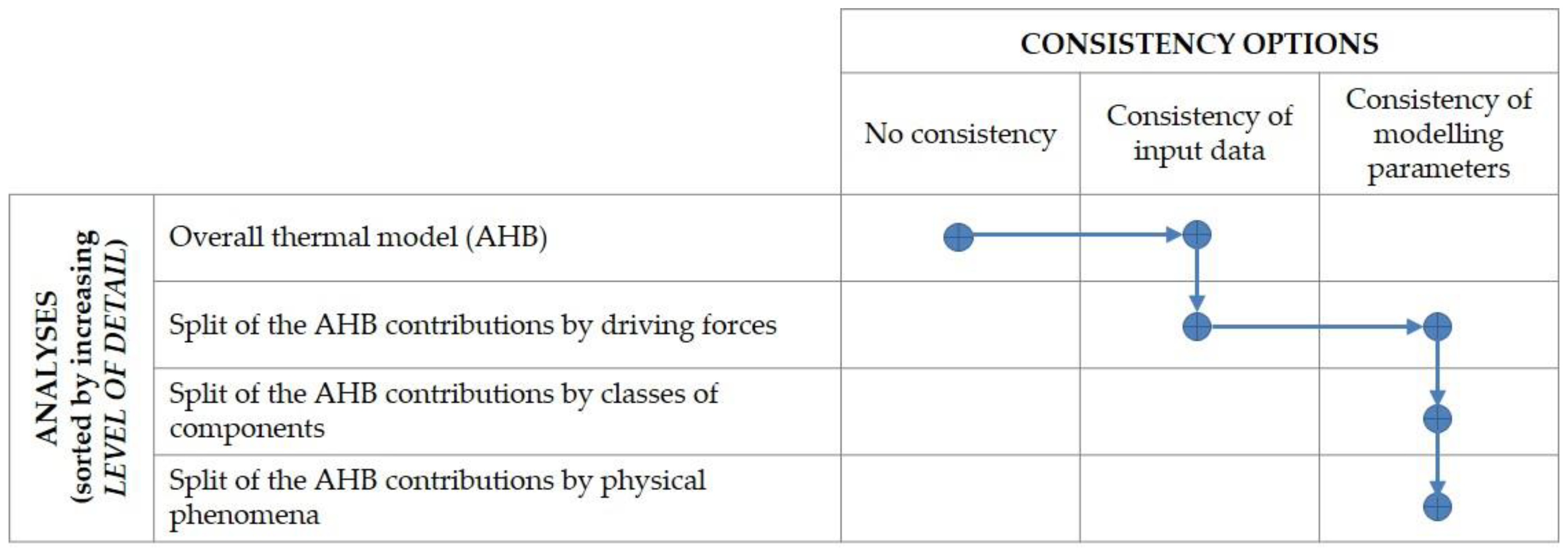
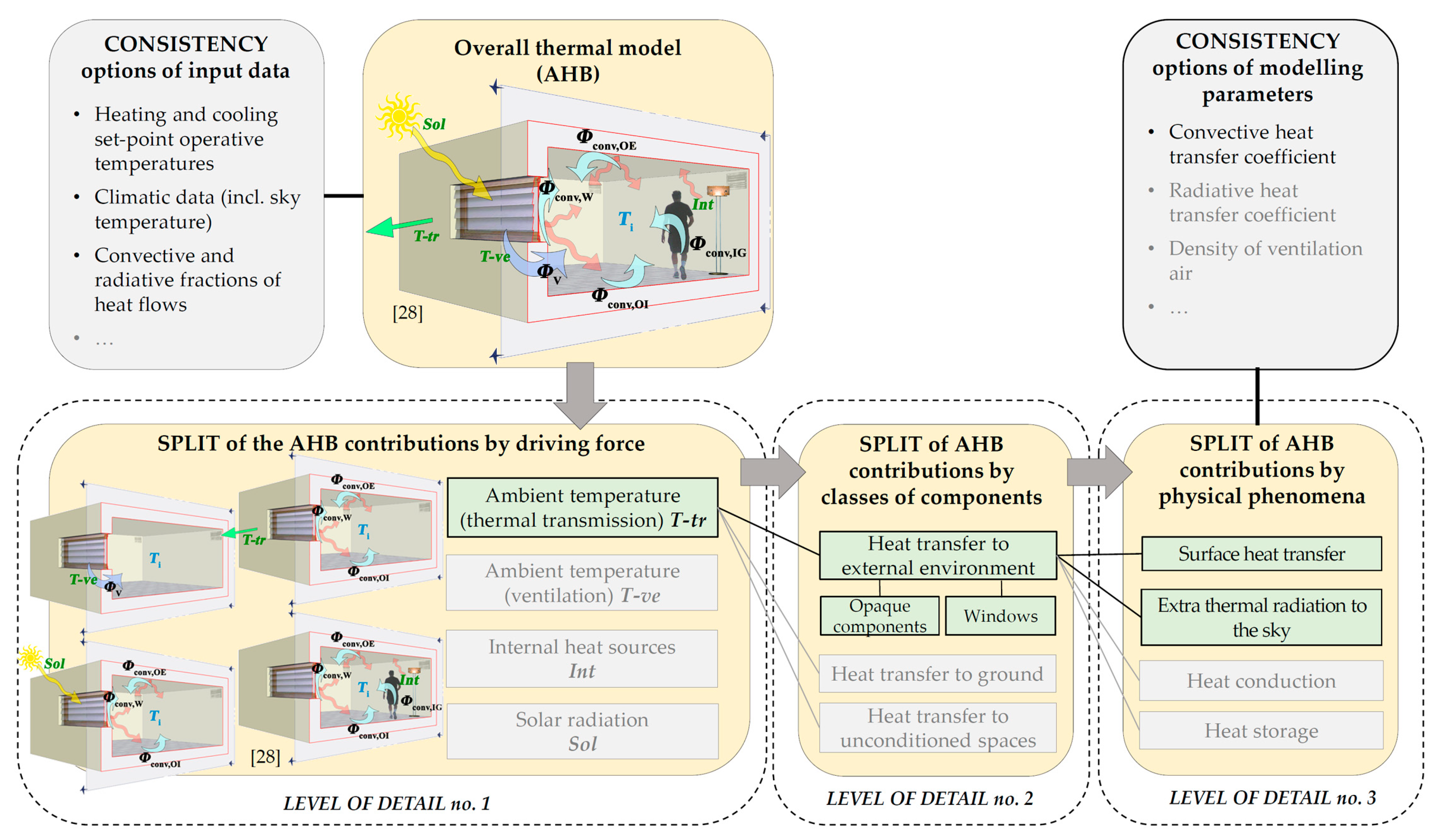


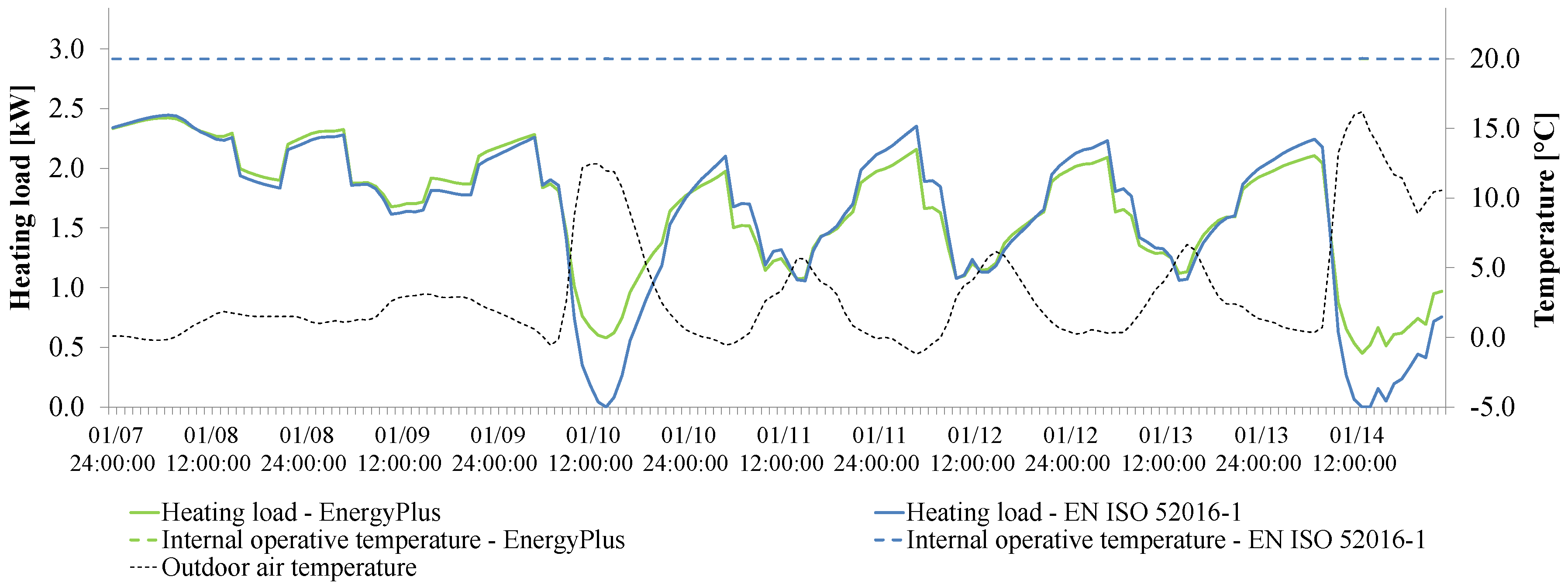

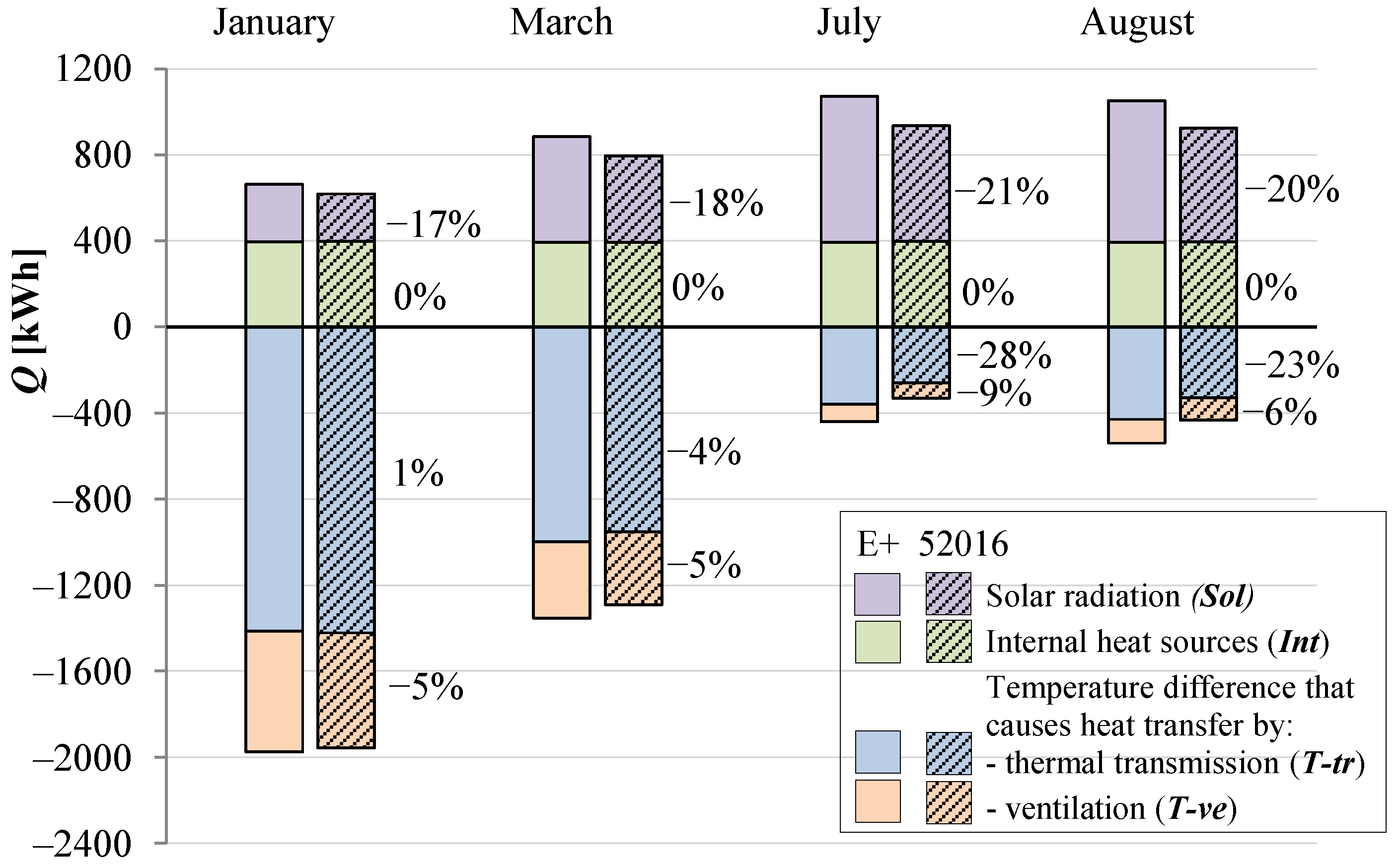
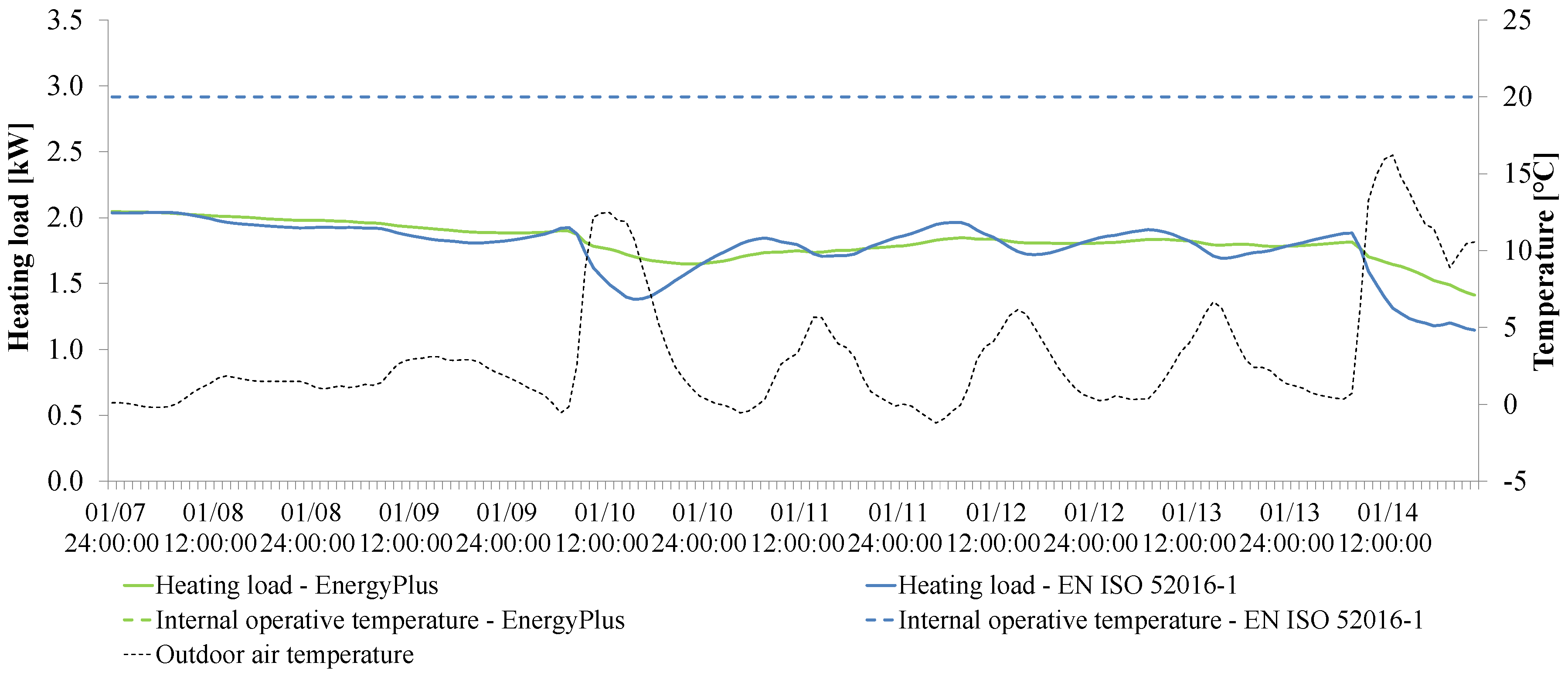
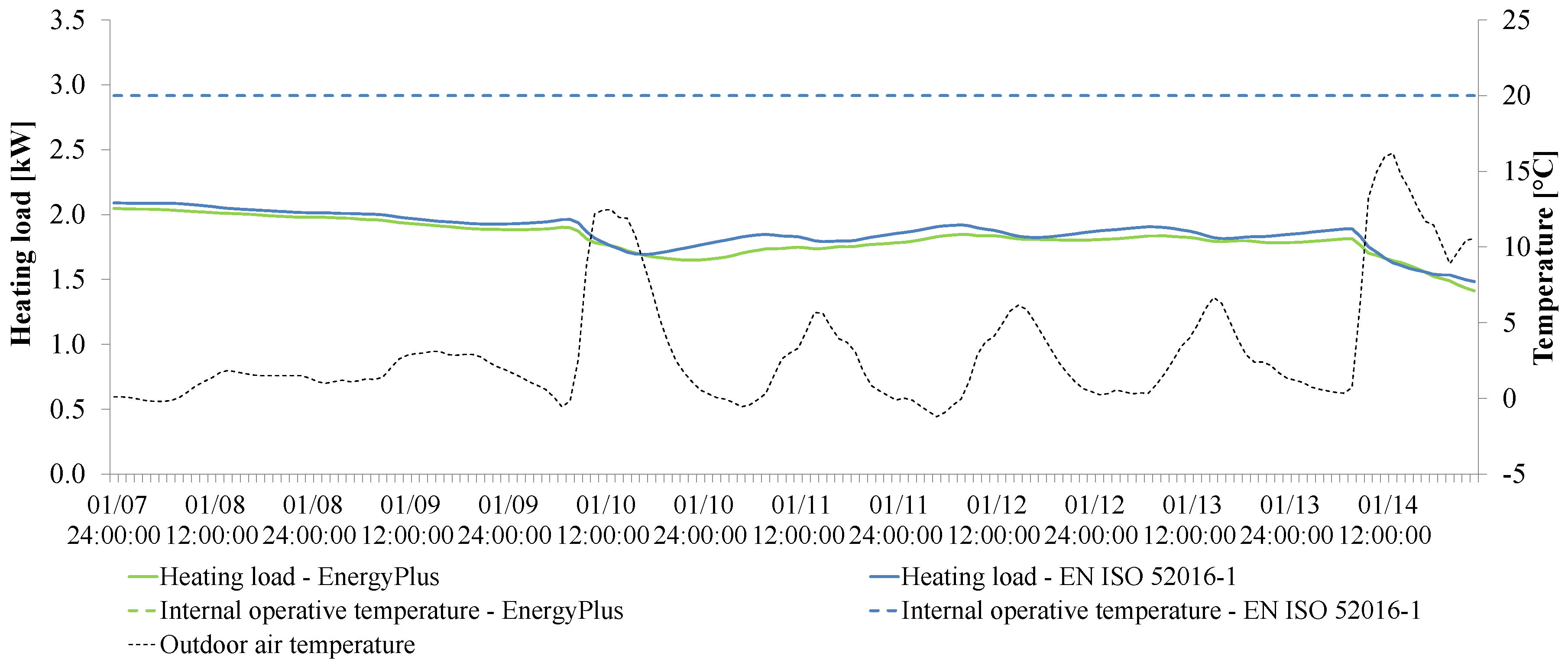
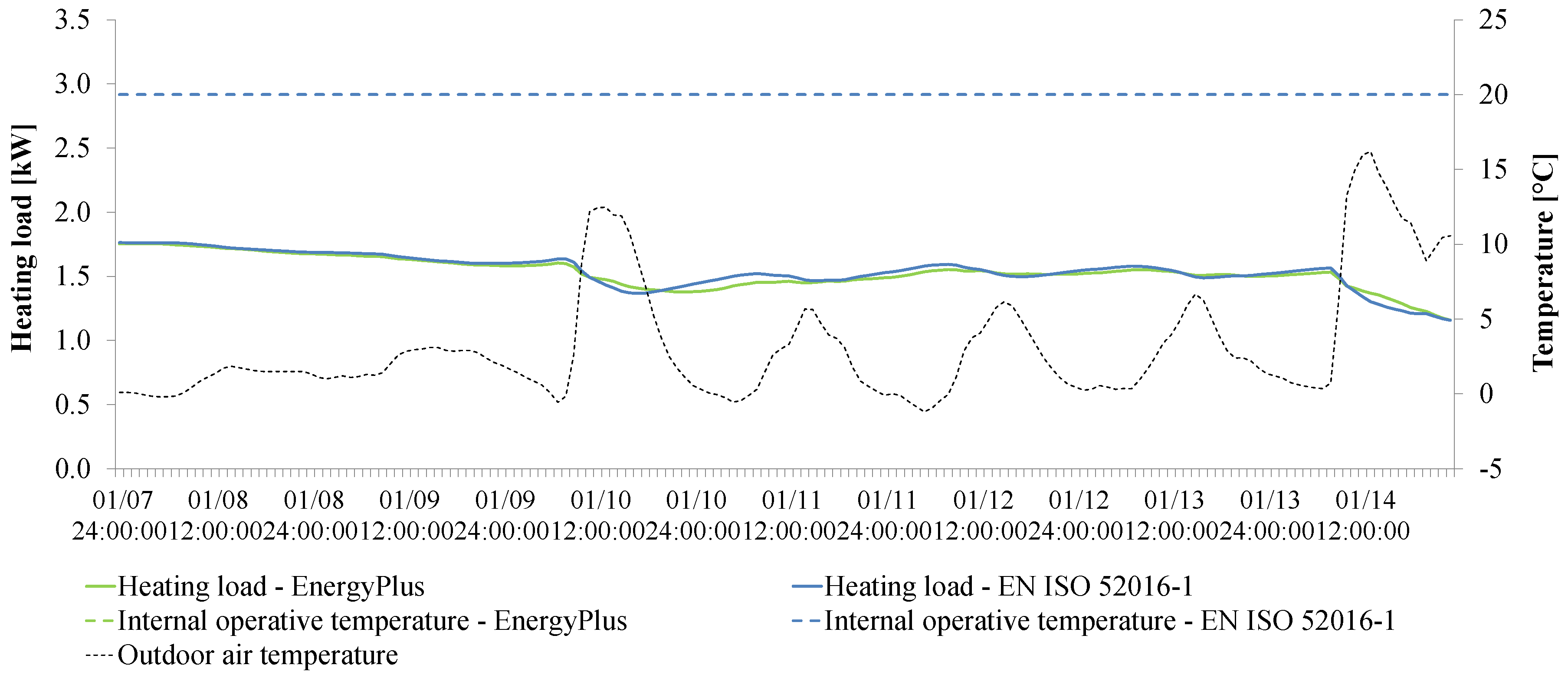
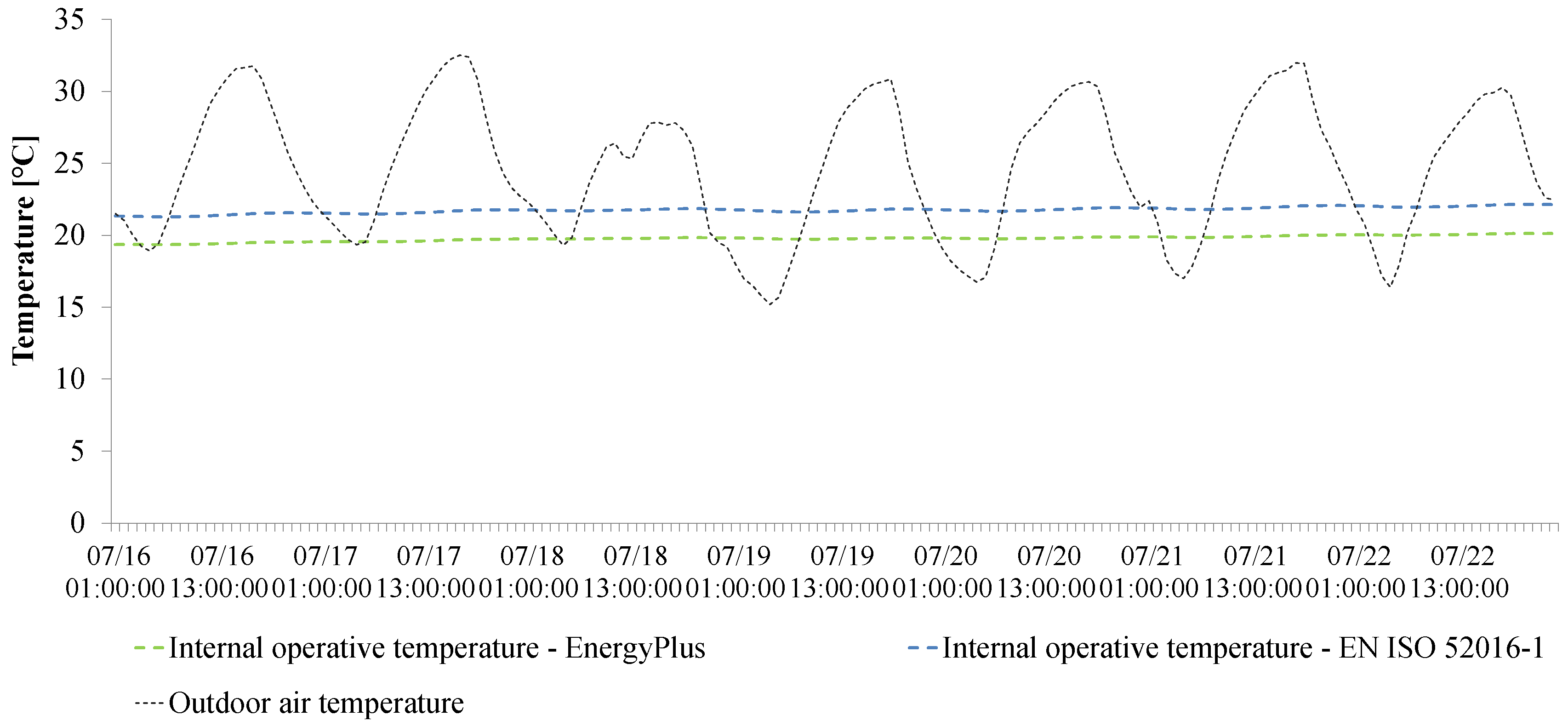
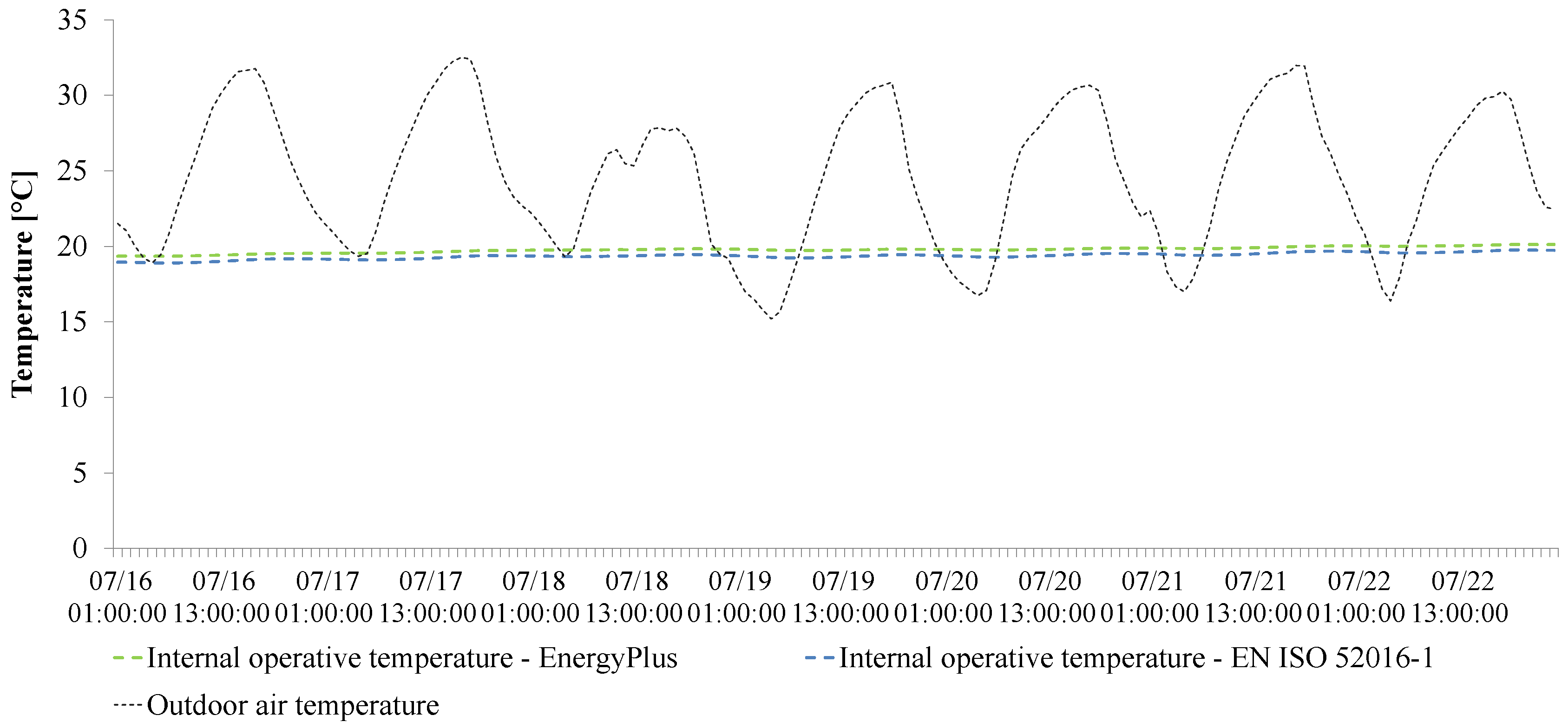
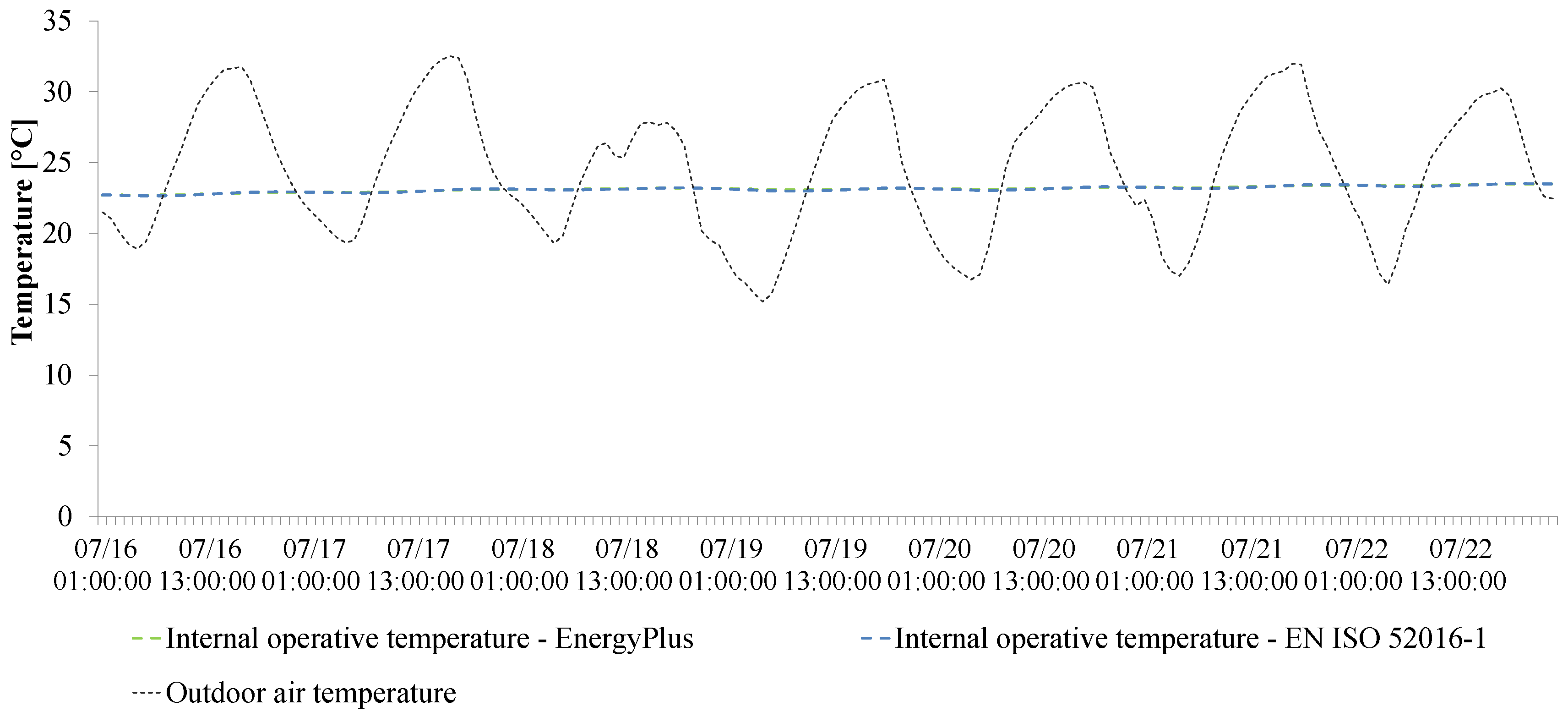
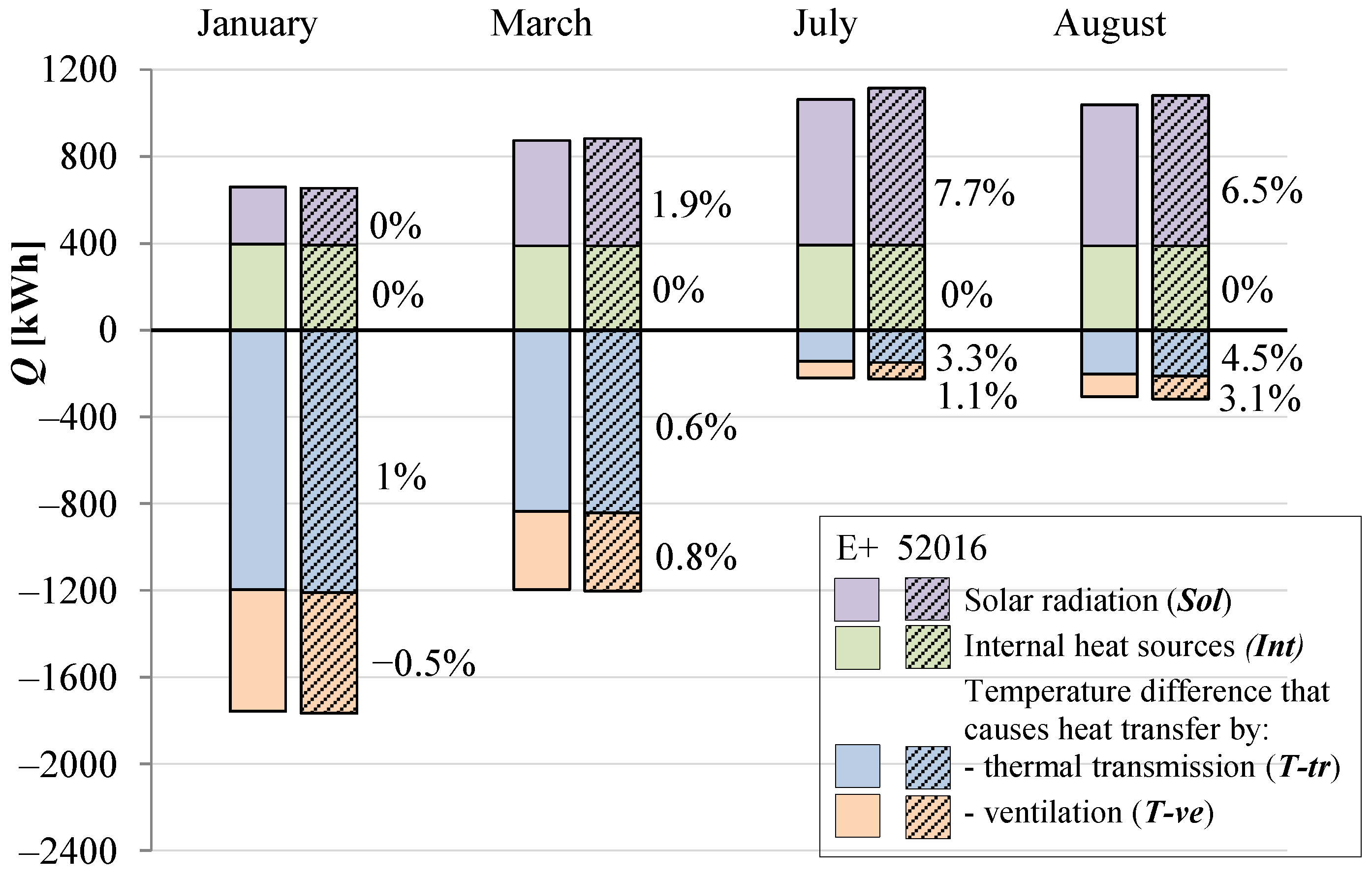
| Quantity | Value | Unit |
|---|---|---|
| Conditioned gross volume, Vg | 362 | m3 |
| Conditioned net volume, Vn | 269 | m3 |
| Conditioned net floor area, Af,n | 99.5 | m2 |
| Compactness ratio, Aenvelope/Vg | 0.69 | m−1 |
| Windows area, Awin | 12.4 | m2 |
| Window-to-wall ratio, WWR | 0.09 | - |
| Building Component | U [W·m−2K−1] | |Yie| [W·m−2K−1] | Δt [h] |
|---|---|---|---|
| External wall | 0.365 | 0.091 | 8.3 |
| Upper floor (roof) | 0.305 | 0.049 | 9.8 |
| Window | 1.62 | - | - |
| Building Component | Material (from the Internal Side to the External Side) | Thermo-Physical Parameters 1 | ||||
|---|---|---|---|---|---|---|
| s [m] | ρ [kg·m−3] | λ [W·m−1K−1] | R [m2·K·W−1] | c [J·kg−1K−1] | ||
| External wall | Gypsum and mortar plaster | 0.015 | 1400 | 0.70 | 0.021 | 840 |
| Brick masonry | 0.16 | 1600 | - | 0.271 | 840 | |
| Expanded polystyrene | 0.10 | 20 | 0.044 | 2.273 | 1250 | |
| Concrete and mortar plaster | 0.025 | 1800 | 0.90 | 0.028 | 840 | |
| Upper floor (roof) | Concrete and mortar plaster | 0.01 | 1800 | 0.90 | 0.011 | 840 |
| Reinforced brick-concrete slab | 0.18 | 1800 | - | 0.30 | 840 | |
| Concrete | 0.02 | 2000 | 1.16 | 0.017 | 1250 | |
| Polyurethane and waterproof finishing | 0.09 | 40 | 0.032 | 2.813 | 1250 | |
| Building Component | C [kJ·m−2K−1] | κinternal [kJ·m−2K−1] | κexternal [kJ·m−2K−1] |
|---|---|---|---|
| External wall | 273 | 60.4 | 39.2 |
| Internal wall (partition) | 65.5 | 52.3 | 52.3 |
| Upper floor (roof) | 342 | 69.0 | 5.80 |
| Intermediate floor | 204 | 71.4 | 62.3 |
| Parameter | EN ISO 52016-1 | EnergyPlus |
|---|---|---|
| Wind speed | not used | required input |
| Air density | fixed value | variable value |
| Total solar energy transmittance of glazing | required input | not required |
| Detailed solar properties of glazing | not required | required input |
| Modeling Options | RMSD [W·m−2] |
|---|---|
| Ambient temperature as the only driving force | 1.23 |
| -plus consistent values of convective heat transfer coefficients | 0.58 |
| -plus removal of extra thermal radiation to the sky | 0.31 |
| Modeling Options | RMSD [°C] |
|---|---|
| Ambient temperature as the only driving force | 1.98 |
| -plus consistent values of convective heat transfer coefficients | 0.41 |
| -plus removal of extra thermal radiation to the sky | 0.04 |
Publisher’s Note: MDPI stays neutral with regard to jurisdictional claims in published maps and institutional affiliations. |
© 2020 by the authors. Licensee MDPI, Basel, Switzerland. This article is an open access article distributed under the terms and conditions of the Creative Commons Attribution (CC BY) license (http://creativecommons.org/licenses/by/4.0/).
Share and Cite
Ballarini, I.; Costantino, A.; Fabrizio, E.; Corrado, V. A Methodology to Investigate the Deviations between Simple and Detailed Dynamic Methods for the Building Energy Performance Assessment. Energies 2020, 13, 6217. https://doi.org/10.3390/en13236217
Ballarini I, Costantino A, Fabrizio E, Corrado V. A Methodology to Investigate the Deviations between Simple and Detailed Dynamic Methods for the Building Energy Performance Assessment. Energies. 2020; 13(23):6217. https://doi.org/10.3390/en13236217
Chicago/Turabian StyleBallarini, Ilaria, Andrea Costantino, Enrico Fabrizio, and Vincenzo Corrado. 2020. "A Methodology to Investigate the Deviations between Simple and Detailed Dynamic Methods for the Building Energy Performance Assessment" Energies 13, no. 23: 6217. https://doi.org/10.3390/en13236217
APA StyleBallarini, I., Costantino, A., Fabrizio, E., & Corrado, V. (2020). A Methodology to Investigate the Deviations between Simple and Detailed Dynamic Methods for the Building Energy Performance Assessment. Energies, 13(23), 6217. https://doi.org/10.3390/en13236217








